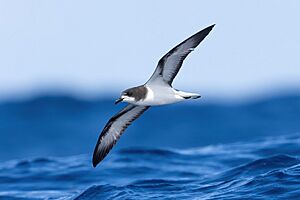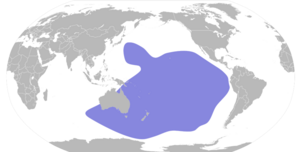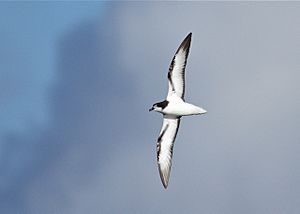Gould's petrel facts for kids
Quick facts for kids Gould's petrel |
|
|---|---|
 |
|
| Conservation status | |
| Scientific classification | |
| Genus: |
Pterodroma
|
| Species: |
leucoptera
|
 |
|
| Synonyms | |
|
Procellaria leucoptera Gould, 1844 Rhantistes velox Bonaparte, 1856 (nomen novum) Cookilaria cookii byroni Mathews, 1916 Pterodroma cookii masafuerae Lönnberg, 1920 |
|
The Gould's petrel (Pterodroma leucoptera) is a type of seabird that belongs to the Procellariidae family. It's named after John Gould, a famous English bird expert and artist who lived from 1804 to 1881.
Contents
About Gould's Petrel
Gould's petrels are small seabirds. They have white feathers on their belly and dark brown and grey feathers on their back. They belong to a group of petrels called Cookilaria. All birds in this group have a dark 'M' shape pattern on their upper wings.
These birds have long, narrow wings and a short, rounded tail. Their head is mostly dark, but they have a white forehead and face. Gould's petrels are about 30 centimeters (12 inches) long. Their wings can spread up to 70 centimeters (27 inches) wide. They weigh between 180 and 200 grams (about 6 to 7 ounces). Male birds are usually a little bigger than females.
Where Do They Live?
Gould's petrels spend most of their lives flying over the ocean. They only come to land when it's time to breed and raise their young.
There are two main groups, or subspecies, of Gould's petrels. One group, called Pterodroma leucoptera leucoptera, breeds mainly on Cabbage Tree Island (John Gould Nature Reserve) and other small islands off the coast of New South Wales, Australia.
The other group, P. l. caledonica, breeds in New Caledonia. These birds are a bit larger and have a stronger beak. They also have lighter feathers on their back and chest. There is also a small group on Raivavae in French Polynesia.
Their Ocean Travels
During the breeding season, both groups of petrels search for food in the Tasman Sea. They might even fly as far west as the Indian Ocean before laying their eggs.
After the breeding season, Gould's petrels migrate across the Pacific Ocean. The Australian group flies to the central Pacific, while the New Caledonian group flies to the eastern Pacific.
What Do They Eat?
Scientists don't know much about what Gould's petrels eat or how they find their food. We do know that they eat small cephalopods (like squid) and fish. Sometimes they have a lot of success finding food, and other times they don't.
Life Cycle and Reproduction
Gadfly petrels, like Gould's petrels, have long breeding seasons. They usually find one partner and stay with them for many years.
Most petrels dig burrows to nest in, and the New Caledonian Gould's petrels do this. However, the Australian Gould's petrels are different. On Cabbage Tree Island, they nest among rocks, under fallen palm leaves, inside hollow tree trunks, and between the roots of fig trees.
Breeding Season in Australia
On Cabbage Tree Island, the birds arrive in mid-October to find a nesting spot and meet up with their mate. In November, they go back to sea for 2 to 3 weeks. This is called the 'pre-laying exodus'.
They lay a single egg between November 18 and December 10. If the egg is lost, they don't lay another one that season. Both parents take turns sitting on the egg, which takes 6 to 7 weeks to hatch. The male usually takes the first long shift, sometimes up to 17 days. The female then takes a shorter turn, and the male finishes the last shift until the egg hatches, usually in January.
The chick grows very quickly and can weigh more than 130% of an adult bird's weight. The young birds leave the nest (fledge) in April or May when they are 80 to 100 days old. At this time, they weigh about 160 to 180 grams.
Growing Up
Scientists don't know exactly how old Gould's petrels are when they start breeding. The youngest Australian bird known to breed was 12 years old. Young birds are thought to spend their first 5 to 6 years at sea. However, during this time, they do visit their home breeding colony. This helps them find a mate and learn how to court and breed.
The oldest known Australian Gould's petrel lived to be at least 23 years old.
Saving the Gould's Petrel
In the early 1990s, there were fewer than 250 breeding pairs of the Australian Gould's petrel. Not many chicks survived, and more adult birds were dying than young birds were successfully leaving the nest. Scientists worried the population was shrinking fast.
What Were the Problems?
Scientists found three main problems:
- Sticky fruit: The fruit of the birdlime tree (Pisonia umbellifera) is very sticky. Birds would get stuck in it and couldn't fly.
- Predators: Birds called pied currawongs (Strepera graculina) were eating the petrel chicks and eggs.
- Habitat damage: European rabbits (Oryctolagus cuniculus) were eating the plants on the island. This meant the sticky birdlime fruit would fall to the ground, making it easier for petrels to get stuck.
How They Helped
To save the birds, people took action:
- In 1993, they removed the birdlime trees from the nesting areas.
- They also controlled the number of pied currawongs.
- Rabbits were completely removed from Cabbage Tree Island by 1997.
These actions worked! The number of young birds successfully leaving the nest increased from fewer than 50 to over 450 each year. The number of breeding adult pairs grew to over 1,000.
Scientists continue to remove birdlime tree seedlings and manage currawongs. They also check the population size each year. Even though scientists visit the nests often, it doesn't seem to bother the birds or affect their breeding success.
New Homes for Petrels
Having almost all the birds on one island was risky. So, scientists created special nest boxes and moved young chicks to nearby Boondelbah Island. Moving young birds is tricky because seabirds usually return to the exact place they were born.
The chicks were moved before they could fly. They were fed by people since their parents weren't there. Scientists had to figure out the best time to move the chicks: young enough so they wouldn't try to return to their first home, but old enough to survive without their parents. This helped create a new, small colony on Boondelbah Island.
Threats to Gould's Petrel
Even with all the help, Gould's petrels still face dangers.
Threats on Land
For the Australian group, the biggest threats are:
- New predators: If animals like cats (Felis catus), black rats (Rattus rattus), foxes (Vulpes vulpes), or dogs (Canus familiaris) were introduced to the islands.
- Wildfires: Especially in December when the birds are sitting on their eggs.
- Accidental egg breakage: Because they nest in tricky spots, eggs can sometimes break.
For the New Caledonian group, the main threats are:
- Introduced predators: Pigs (Sus scrofa) dig up their burrows, and black rats eat birds and eggs.
- Lights: Adult birds are sometimes killed at night when they fly into bright lights in the city of Nouméa.
Threats at Sea
Scientists don't know much about the threats Gould's petrels face while they are out at sea. They don't seem to be directly harmed by long-line fishing, which is a problem for some other seabirds.



